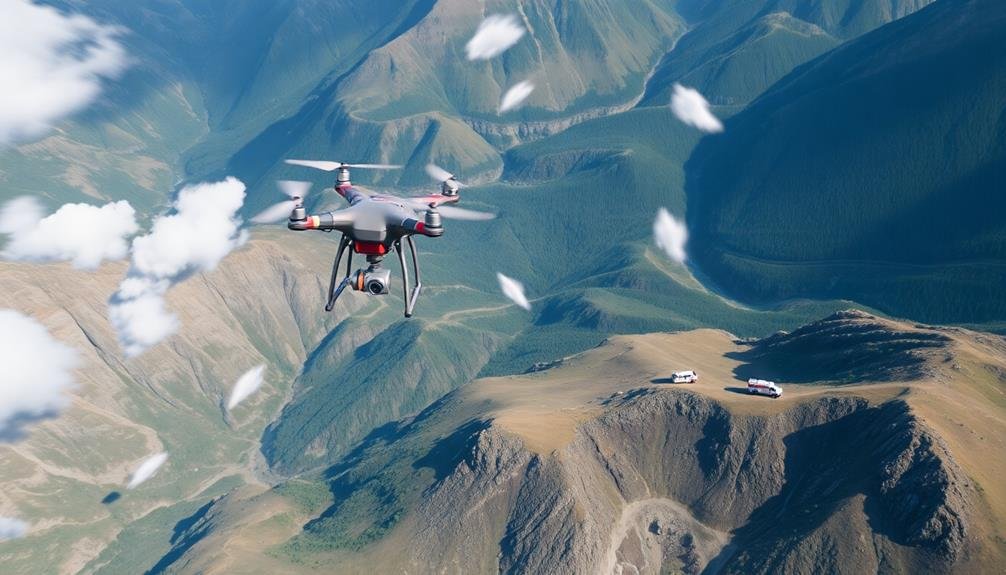When planning autonomous rescue missions, focus on three key areas to maximize effectiveness. First, assess environmental conditions thoroughly, gathering data on terrain, weather, and potential hazards to guarantee your vehicles are prepared. Second, optimize flight path algorithms using machine learning and historical data to improve navigation efficiency and safety. Third, implement robust communication systems with redundant technologies and encryption to maintain reliable connections in challenging environments. By mastering these aspects, you'll enhance your mission's success rate and save more lives. Dive deeper into these strategies to take your autonomous rescue planning to the next level.
Assess Environmental Conditions

Environmental assessment is essential for successful autonomous rescue missions. You'll need to gather extensive data about the terrain, weather conditions, and potential hazards in the target area. Start by analyzing satellite imagery and topographical maps to understand the landscape.
Consider elevation changes, vegetation density, and water bodies that might affect your autonomous vehicles' navigation.
Next, evaluate current and forecasted weather patterns. Wind speed, precipitation, and temperature can impact your equipment's performance and the mission's overall safety.
Don't forget to assess visibility conditions, such as fog or sandstorms, which could interfere with sensors and cameras.
Identify potential hazards like unstable structures, chemical spills, or radiation sources. This information will help you select appropriate sensors and protective measures for your autonomous systems.
Also, consider the time of day for the mission, as lighting conditions can affect visual recognition capabilities.
Lastly, assess communication infrastructure in the area. Determine if there are any dead zones or interference sources that could disrupt data transmission between your autonomous vehicles and the command center.
Optimize Flight Path Algorithms

Once you've assessed the environmental conditions, it is crucial to improve flight path algorithms for your autonomous rescue vehicles. These algorithms determine how efficiently and safely your drones navigate to reach their targets. Focus on developing algorithms that can adapt to changing conditions and obstacles in real-time.
Incorporate machine learning techniques to enhance your algorithms' performance over time. Use historical data from previous missions to train your models, enabling them to make better decisions in similar scenarios. Consider implementing a multi-objective improvement approach that balances factors like speed, safety, and energy efficiency.
| Algorithm Type | Advantages | Disadvantages |
|---|---|---|
| A* Search | Efficient pathfinding | High memory usage |
| Genetic Algorithms | Adaptable to complex terrains | Computationally intensive |
| Rapidly-exploring Random Trees | Quick obstacle avoidance | May not find best paths |
Don't forget to integrate sensor fusion techniques to enhance your algorithms' accuracy. Combine data from various sensors like GPS, LiDAR, and cameras to create a thorough understanding of the environment. Regularly test and refine your algorithms in simulated environments before deploying them in real-world rescue missions.
Implement Robust Communication Systems

With optimized flight paths in place, your focus should shift to implementing robust communication systems. These systems are essential for maintaining contact with autonomous rescue vehicles and guaranteeing mission success.
You'll need to take into account various factors to create a reliable communication network that can withstand challenging environments and potential disruptions.
To implement a robust communication system, follow these key steps:
- Choose appropriate communication technologies: Select a mix of radio frequencies, satellite links, and mesh networks to provide redundancy and coverage across different terrains.
- Implement data encryption: Secure your communications to protect sensitive information and prevent unauthorized access or interference.
- Establish relay stations: Set up strategically placed relay points to extend the range of your communication network and overcome obstacles like mountains or buildings.
- Develop fail-safe protocols: Create contingency plans for communication failures, including autonomous decision-making capabilities for rescue vehicles when they lose contact.
Don't forget to test your communication systems thoroughly under various conditions.
Simulate different scenarios, including extreme weather and equipment malfunctions, to identify and address potential weaknesses. Regular maintenance and updates will help guarantee your communication systems remain effective and reliable throughout rescue missions.
Frequently Asked Questions
What Safety Protocols Are in Place for Autonomous Rescue Drones?
You'll find autonomous rescue drones equipped with collision avoidance systems, emergency landing protocols, and fail-safe mechanisms. They're programmed with strict operational boundaries and undergo regular maintenance. You should also guarantee they're compliant with local aviation regulations.
How Are Rescue Targets Identified and Prioritized by Autonomous Systems?
You'll find that autonomous systems identify rescue targets using sensors and AI. They prioritize based on urgency, using factors like crucial signs, location, and environmental hazards. You can adjust these priorities as needed for specific missions.
What Ethical Considerations Arise When Using AI for Rescue Operations?
You'll face ethical dilemmas using AI for rescues. You must consider privacy, data bias, and prioritization decisions. You're responsible for potential errors or unintended consequences. You'll need to balance efficiency with human oversight and compassion.
How Do Autonomous Rescue Missions Integrate With Human-Led Efforts?
You'll find autonomous rescue missions complement human efforts. They'll work alongside your teams, providing valuable data and reaching areas you can't. You'll coordinate operations, with AI assisting decision-making and enhancing your overall rescue capabilities.
What Are the Legal Implications of Using Autonomous Drones in Rescue Missions?
You'll need to take into account privacy laws, liability issues, and airspace regulations when using autonomous drones in rescues. It's vital to obtain proper permits and guarantee your operations comply with local and federal aviation rules.
In Summary
You've now got the key elements for planning autonomous rescue missions. Remember to thoroughly assess environmental conditions, fine-tune your flight path algorithms, and establish reliable communication systems. Don't underestimate the importance of each step. By implementing these tips, you'll improve your mission's effectiveness and safety. Keep refining your approach as technology advances, and you'll be well-prepared to tackle challenging rescue scenarios with your autonomous systems. Stay focused and keep innovating!

As educators and advocates for responsible drone use, we’re committed to sharing our knowledge and expertise with aspiring aerial photographers.




Leave a Reply